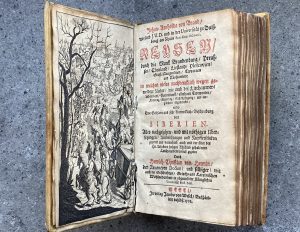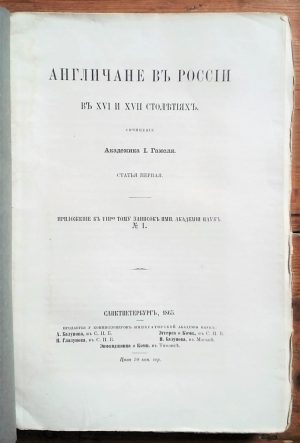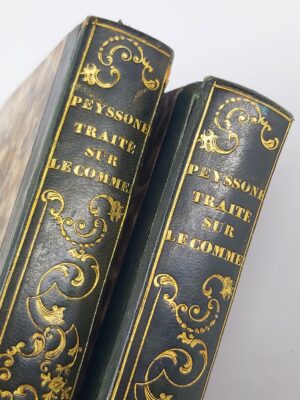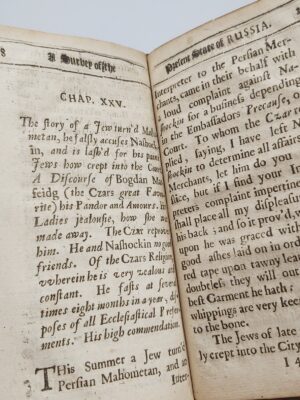Our Notes & References
First edition of this rich and important eyewitness account of the Baltic lands, Russia and Siberia in the 17th century. Its illustration includes a panorama of the Moscow kremlin and possibly the first depictions of amber mining and sable hunting on skis.
A fine example, in contemporary binding, rare such: although copies seem to be available in public institutions, we could trace only one complete copy at auction in recent decades – but rebound.
In March 1673, Brand (1647-90) joined the embassy sent by the Brandenburg elector Friedrich Wilhelm to Tsar Alexei Mikhailovich, who had asked for Prussian support against the Turks. During his travels from Berlin via Dantzig (Gdańsk), Königsberg (now Kaliningrad), Riga, Pskov, Novgorod and Tver to Moscow, Brand wrote detailed observations and many comments and corrections of previous descriptions, especially Olearius’ celebrated Vermehrte Newe Beschreibung, which was then the last updated account of Muscovy.
Brand’s observations are notable for their comprehensiveness and accuracy. All the way from Berlin, he focused on the local cultures and customs (such as Latvian bath-houses or Lithuanian children education), political organizations, geography and, perhaps more unusually, on the languages and music: the edition includes several vocabularies (Lithuanian, Latvian, Russian) and songs in the original language, also translated in German, quoting for example Lithuanian proverbs and drinking songs, and giving “the earliest examples of Latvian dainas [type of folk songs], published for a Western readership” (Kloss). One of the plates represents the blind organist, composer and “philosophus” from Königsberg, Ulrich Schönberger (1601-49).
Brand also included a ‘General Description of Siberia’, a text which he received in manuscript from his compatriot Albrecht Dobbin, who at that time served in Siberia as a captain of the Tsar for 17 years. Dobbin briefly describes Western, Central and Southern Siberia, mentioning Kazan, Astrakhan as well as various peoples of this vast land, such as Kalmyks and even Kirghiz. Brand added his own comments, including a most interesting description of sable hunting, illustrated in details by a folding plate, which may well be its first depiction, or even the first full hunting scene on skis.
Two other plates are of special note: one shows amber extraction on the shores of the Königsberg peninsula – also its first depiction probably, as we could not find such an illustration in previous mining works, especially Agricola’s major opus.
The other remarkable illustration is a larger folding plate depicting an important procession in front of the Moscow Kremlin and St. Basile cathedral, most probably for Palm Sunday, still carried out when Brand visited Moscow, but not anymore when the book was published: such celebrations were indeed forbidden as soon as 1678. Other illustrations include, among others, plans and views of cities such as Königsberg, Gdańsk, Riga, Velikii Novgorod and Tver.
Brand died rather young, and we owe to his friend and colleague Heinrich-Christian von Hennin this “excellent publication that made available a lot of interesting information that otherwise would have been lost” (Kloss). A professor at the Duisburg university, Hennin significantly augmented Brand’s work with his introduction, a funerary oration and extensive, erudite notes, comments, remarks and corrections over c. 150 pages.
Provenance
From the estate of Geoffrey Elliott (1939-2021), banker of Russian descent, author of books on 20th-c. history. Acquired from Bernard Quaritch Ltd. In 2006. Geoffrey and his wife Fay were noted collectors, especially of Oscar Wilde, Evelyn Waugh and other literary figures. Russia was also an important theme: Geoffrey’s grandparents were interned in a Siberian tsarist prison camp before the October Revolution, and he focused most of his published works on the Cold War.
The Elliotts donated a significant part of their collection to the library of Leeds University in 2002, but kept the Russia-related items, which we consequently acquired.
Bibliography
Adelung II, 118; Cat. Russica B-1854; Erich Donnert, Alt-Russisches Kulturlexikon, VEB Bibliographisches Institut Leipzig 1988; Jürgen Kloss, “Exotic” Songs and Tunes in European Publications 1577-1830 (online).
Physical Description
Octavo (15.7 x 9.5 cm). Engraved frontispiece, title printed in red and black, [xliv] incl. dedication with an engraved vignette and introduction, 516, 4 pp., with 15 engraved plates incl. 12 folding.
Binding
Contemporary vellum with overlapping edges, flat spine, titled in ink.
Condition
Binding a bit soiled and rubbed, small hole on spine. Very occasional minor spotting, two small slits in gutter of frontispiece, illegible round black ink stamp to front. recto, a couple of brittle edges, one marginal paper flaw; but a pleasant, rather crisp example.



























